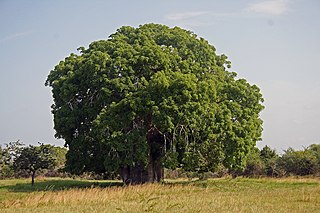
Adansonia is a genus made up of eight species of medium-to-large deciduous trees known as baobabs. They are placed in the Malvaceae family, subfamily Bombacoideae. They are native to Madagascar, mainland Africa, and Australia. The trees have also been introduced to other regions such as Asia. The generic name honours Michel Adanson, the French naturalist and explorer who described Adansonia digitata. The baobab is also known as the "upside down tree", a name that originates from several myths. They are among the most long-lived of vascular plants and have large flowers that are reproductive for a maximum of 15 hours. The flowers open around dusk, opening so quickly that movement can be detected by the naked eye, and are faded by the next morning. The fruits are large, oval to round and berry-like and hold kidney-shaped seeds in a dry, pulpy matrix.

Joseph Marie Henry Alfred Perrier de la Bâthie was a French botanist who specialized in the plants of Madagascar.
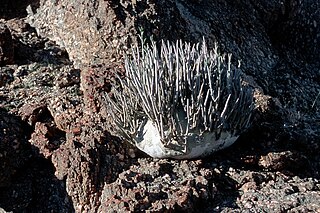
Adenia is a genus of flowering plants in the passionflower family Passifloraceae. It is distributed in the Old World tropics and subtropics. The centers of diversity are in Madagascar, eastern and western tropical Africa, and Southeast Asia. The genus name Adenia comes from "aden", reported as the Arabic name for the plant by Peter Forsskål, the author of the genus.

Adansonia digitata, the African baobab, is the most widespread tree species of the genus Adansonia, the baobabs, and is native to the African continent and the southern Arabian Peninsula. These are long-lived pachycauls; radiocarbon dating has shown some individuals to be over 2,000 years old. They are typically found in dry, hot savannas of sub-Saharan Africa, where they dominate the landscape and reveal the presence of a watercourse from afar. They have traditionally been valued as sources of food, water, health remedies or places of shelter and are a key food source for many animals. They are steeped in legend and superstition. In recent years, many of the largest, oldest trees have died, for unknown reasons. Common names for the baobab include monkey-bread tree, upside-down tree, and cream of tartar tree.
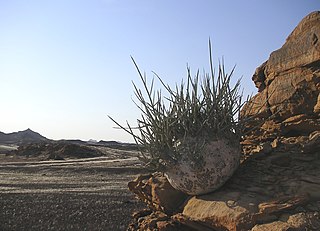
Adenia pechuelii is a species of plant in the family Passifloraceae. It is endemic to Namibia. Its population is made up of mostly small subpopulations, and most of these are affected by collecting, but it is currently considered to be a species of least concern.

Cucurbita palmata is a species of flowering plant in the squash family known by the common names coyote melon and coyote gourd. It is similar to Cucurbita californica, Cucurbita cordata, Cucurbita cylindrata, and Cucurbita digitata and all these species hybridize readily. It was first identified by Sereno Watson in 1876. These species form the only restricted xerophyte species group in the genus Cucurbita. Each member of this species group is native to the Southwestern United States and Northwestern Mexico where they are relatively uncommon. Each group member is found in hot, arid regions with low rainfall. They prefer soil that is loose, gravelly, and well-drained. C. palmata is native to northeastern Baja California, southeastern California, and southwestern Arizona to a point near the Colorado River. The juvenile leaves of C. cylindrata, C. cordata, C. digitata, and C. palmata show a high degree of similarity, but their mature leaves are visibly different, as are their root structures. C. palmata and C. digitata are sympatric, with C. palmata separating the ranges of C. digitata at the juncture of Baja California, California, and Arizona. C. palmata fruits are diffuse green mottle that turns yellow at maturity, striped, and round.

Cucurbita digitata is a species of flowering plant in the squash family known by the common names fingerleaf gourd and bitter squash. It is similar to Cucurbita californica, Cucurbita cordata, Cucurbita cylindrata, and Cucurbita palmata and all these species hybridize readily. These species form the only restricted xerophyte species group in the genus Cucurbita. Each member of this species group is native to the Southwestern United States and Northwestern Mexico where they are relatively uncommon. Each group member is found in hot, arid regions with low rainfall. They prefer soil that is loose, gravelly, and well-drained. C. digitata is native to northern Baja California at higher elevations, northern Sonora, Mexico, southern Arizona, and southwestern New Mexico. The juvenile leaves of C. cylindrata, C. cordata, C. digitata, and C. palmata show a high degree of similarity, but their mature leaves are visibly different, as are their root structures. C. palmata and C. digitata are sympatric, with C. palmata separating the ranges of C. digitata at the juncture of Baja California, California, and Arizona. C. digitata fruits are clear green mottle that turns yellow at maturity, striped, and round.

Cadarena is a monotypic moth genus of the family Crambidae erected by Frederic Moore in 1886. Its only species, Cadarena pudoraria, was first described by Jacob Hübner in 1825. It occurs throughout tropical and subtropical Africa and in India.
Lophacme is a genus of African plants in the grass family.
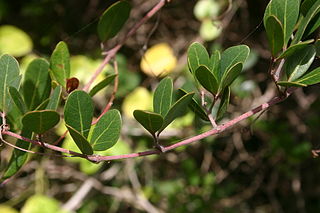
Rhoicissus digitata is a vigorous, evergreen vine that is indigenous to southern Africa. It is increasingly popular as an ornamental creeper in gardens, and it has a wide range of uses in traditional medicine.
M. digitata may refer to:

Adenia globosa is a species of flowering plant in the passionflower family, Passifloraceae. It is native to tropical Africa, where it occurs in Ethiopia, Kenya, Somalia, and Tanzania. It is known as mpaga in Swahili.

Adenia hondala, commonly known as hondala is a large, tuberous, woody climber which scrambles over other plants. It is found in the Indian subcontinent, including Sri Lanka, and in southeastern Asia. The tuber and the fruit are used as herbal remedies and the plant is used as a cure for snake bites. The caterpillars of several species of butterfly feed on this plant; these include the tawny coster, the clipper, the common cruiser and the Tamil lacewing.
Volkensin is a eukaryotic ribosome-inactivating protein found in the Adenia volkensii plant. It is a glycoprotein with two subunits A and B. A subunit is linked to B subunit with disulfide bridges and non-covalent bonds. B subunit is responsible for binding to the galactosyl-terminated receptors on the cell membrane that allows the entry the A subunit of the toxin into the cell, which performs the inhibitory function. Volkensin is a galactose specific lectin that can inhibit protein synthesis in whole cells and in cell-free lysates. This protein can be included into the category of risin like toxins and it resembles modeccin, the toxin of Adenia digitata. Although very similar in composition, volkensin contains more cysteine residues and more than twice as much sugar than modeccin, due to high content of galactose and mannose. In addition, volkensin is able to inhibit protein synthesis at concentrations 10 times lower than required for modeccin. From gene sequencing analysis, volkensin was found to be coded by 1569-bp ORF, that is 523 amino acid residues without introns. The internal linker sequence is 45 bp. The active site of the A subunit contains Ser203, a novel residue that is conserved in all ribosome inactivating proteins.

Adenia glauca is a species of flowering plant in the passionflower family, Passifloraceae. It is native to southern Africa, where it occurs in southeastern Botswana and northern South Africa.

Adenia fruticosa is a species of flowering plant in the passionflower family, Passifloraceae. It is native to KwaZulu-Natal and the Northern Provinces of South Africa and to Zimbabwe.
Adenia cissampeloides is a species of flowering plant in the passionflower family, Passifloraceae. It is native to tropical Africa.
Modeccin is a toxic lectin, a group of glycoproteins capable of binding specifically to sugar moieties. Different toxic lectins are present in seeds of different origin. Modeccin is found in the roots of the African plant Adenia digitata. These roots are often mistaken for edible roots, which has led to some cases of intoxication. Sometimes the fruit is eaten, or a root extract is drunk as a manner of suicide.
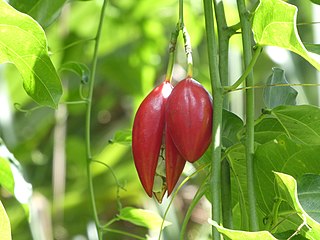
Adenia heterophylla, commonly known in Australia as the lacewing vine, is a climbing plant in the family Passifloraceae. It has a broad distribution spanning the equator, from the south eastern corner of China, through Indochina and Malesia, to northern Australia. In Australia it serves as a food plant for larvae of the glasswing, red lacewing and cruiser butterflies.














